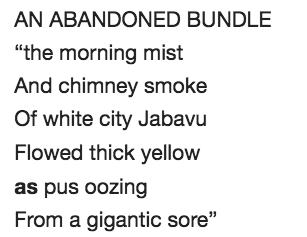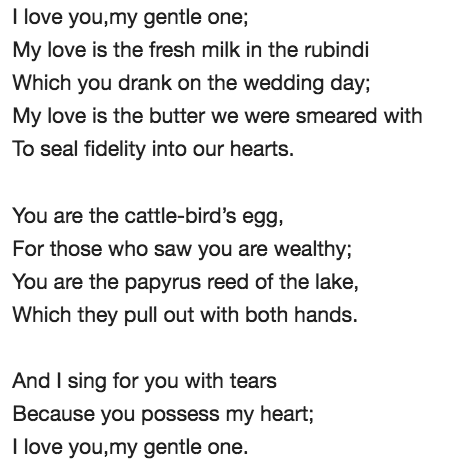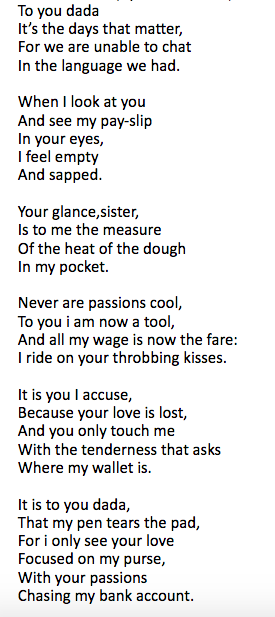POETRY ANALYSIS
>>Poems for Secondary Students, click here
The Form in Poetry
Poetry can be defined as a writing that formulates a concentrated, imaginative awareness of experience chosen and arranged to create a specific emotional response through its meaning, sound and rhythm.
Unlike other forms of creative writing, Poetry concentrates, sharpens and condenses what it has to say.
KINDS OF POETRY
- Narrative Poetry: This is a kind of poetry that narrates a story. For example,in the poem “Always a suspect” the poet is telling us the story of a black young boy in South Africa who was suspected to be a thief for his appearance and had to show documents to prove that he is innocent.
- Didactic Poetry: This is the type of poetry whose aim is instructional to the reader rather than an appeal to his imaginative understanding. They have explicit political or social messages e.g poverty, development, diseases.
- Lyrical Poetry: These are poems which express the thoughts and particularly the feelings of the writer. For example, Love poems are Lyrical e.g “I love my Gentle one”
THE USE OF MUSIC
Poetry is the product of oral traditions and songs. The musical elements of poetry are an important part of attraction.
- Rythm:A pattern of stress in speech. Rhythm is used to add to both the meaning and music. Important words in the poem are given stress. For example, from the poem, “If we must die”t he word in vain is given a stress.
- The repetition of sounds: Poems have repetition of sounds in certain parts. The repetition of the same or similar sounds at the end of lines of poem. For example, in the poem”EAT MORE” the words, ‘say’ and ‘pay’, ‘bread’ and ‘wed’ rhyme the same.

- Alteration:Repetition of the same sound at the beginning of words e.g The Girls Giggled like a Gaggle of Geese
- Refrain: The words or lines repeated at the end of each stanza. It can be very long or very short. For example, in the poem “Atieno Yo”

The repetition here shows the monotony of the work.
THE USE OF LANGUAGE
- Imagery:Language is full of imagery. Imagery means the creation of pictures with words e.g snow, lion, jewel etc.
- Simile:This is the comparison of two dissimilar things using the words “like” or “as”. In the poem “An Abandoned Bundle” simile is used.

- Metaphor:This is a comparison of two dissimilar things but without using the words “like” or “as” e.g He was a lion in battle.
- Personification:Giving human qualities to something which is not human. For example,in the poem ”The Vultures” the terms civilization and holy water are given human qualities to act as humans.
- Symbol:The word or an image that represents other or more meaning than what it represents in common. For example the word “Piano” can represent western culture and “Drums” can represent African culture.
- Understatement: Is the tendency whereby the poet deliberately avoids stressing his points too much, even when talking about something which one has to be serious.
OTHER COMMON TERMS IN POETRY
- Persona: The use of the pronoun “I” in the poem refers to the poet who writes the poem.
- Verse:A single line in a poem.The combination of verses form a stanza.
- Poetic Licence:This is the ability given to the poet to use broken English to fullfil his/her needs of conveying a message to the audience e.g “Your lost” instead of “You are lost”
FORM OF THE POEM
- Type of the poem:Free verse/open form type of a poem.
- Structure: The poem has four stanzas. The first stanza has seven verses, the second stanza has eight verses, the third stanza has five lines, and the last stanza has one verse.
- Diction:The language used is clear and straight forward.
- Figures of speech:Personification e.g”Hollow heads torture me”. Irony – The persona calls his enemies friends (3rd stanza).
- Tone/Voice:The tone is serious because the persona is ready to fight till his/her last blood.
- Mood:The mood of the persona is sad because he/she is oppressed, tortured, harassed and confused.
By Ralph Bitamazire

Question Time 1
From the poem above, comment on the following:
- Mood
- Diction/language use
Mood
- The poet is happy and sings for his lover with happy tears
Diction/language use
- The language used is straight forward since it is easy to understand. The poet used metaphor in his work e.g “My love is the fresh milk in the Rubindi” “My love is the butter we were smeared”
Question Time 2
What are the possible themes of the poem?
The possible themes of the poem are; true love, traditional marriage, oath
Question Time 3
Comment on the structure of this poem.
The poem has three stanzas. The first stanza has five (5) verses, the second stanza has four (4) verses, while the third stanza has three (3) verses.
Content in Poetry
Poem is a metrical composition characterized by strong imagination,emotion and appropriate language.
THE CONTENT OF A POEM
- Tone is a feature of a poem which shows the author’s attitude.For example,in the poem Mamparra M’gaiza,the poet uses the word ‘’stupid’’ and “cattle” to wake up the contract workers.
- Diction is the choice and arrangement of words in a poem.A poet has to be careful in selection of words to use in the poem.
- Internal structure is the way the poem is developed,the way the poet develops his ideas makes us to know what he wants to say.For example,in the poem”EAT MORE”,the poet draws a picture of a person who is encourage to eat balanced diet while he is jobless and has no money.The poet develops the poem by saying that what she/he can afford is to “Eat more bloody grass”.
HOW TO ANALYSE A POEM
- Understand well the title of the poem: Understanding the title of the poem makes a reader to predict the content of the poem.For example,the title”Your pain” can be predicted that there is suffering as a focus in the poem.
- Consider the form and type of the poem:Judge whether the poem is Lyric,narrative,ballad etc.You have to state whether the poem is Open(free verse),or closed.
- Consider the Tone of the poet:The attitude or mood of the poet has great contribution to interpretation of a poem.The poet determines whether the poet is angry,happy,sad,or serious.
- Consider the musical or sound features of a poem:Consider Rhyme,Rhythm,alliteration or refrain.These features are very important in poetry.
- Think about possible themes:Consider the poets’ central idea of discussion.In the poem,there is one or more themes.
- Consider the message of a poem:The message refers to what the poet wants the readers to know or do after reading the poem e.g avoid child labor,misuse of power etc.
- Consider the relevance of the poem:Look at the issues/themes raised in the poem.Relate what you read in the poem with what happens in your community.
- Consider Language use:Study how the language has been used in moulding the poem.Consider diction(choice of words),symbols and symbolism and the uses of figures of speech e.g Metaphor,Simile,personification etc.
- Comment on success or failure of the poet:check the use of language,presentation of message and themes etc.




